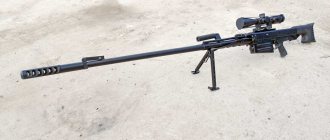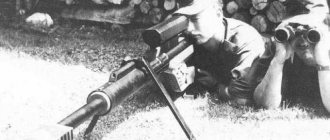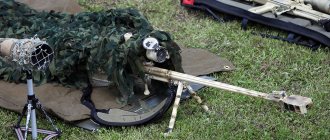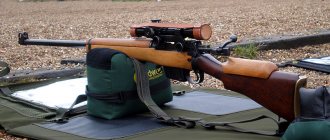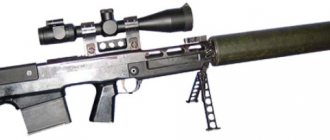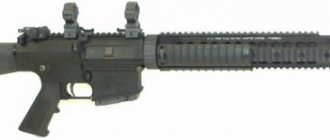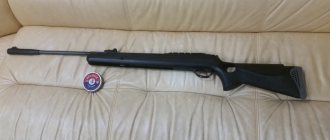One of the few very compact, powerful, mobile and effective large-caliber rifles is the Hungarian development of Gepard Model 6 Lynx, which means “Cheetah Model 6 Lynx”. Thanks to the bullpup design, it fits into a hunting backpack. The use of the latest technologies has made it possible to significantly reduce the recoil from each shot, which, in turn, allows you to shoot it directly from your hands. And this is only part of a large list of all the advantages of the GM6 rifle.
GM6
History of the Gepard series
The production of weapons under the Gepard brand began in World War II. At that time, Hungarian designers created anti-tank rifles that effectively fought against lightly armored targets, in particular against British equipment. But soon the armored vehicles of almost all countries received more powerful armor, with which anti-tank rifles could not compete. One way or another, large-caliber weapons were remembered in Hungary in 1987, trying to create a convenient weapon capable of penetrating light armor. Developments lead to the creation of large-caliber rifles in the Gepard series.
Now rifles in this series are distinguished by their penetrating abilities, as well as the range and speed of the bullet. High accuracy is the priority of every Gepard rifle.
Gepard M1/M2/M3 large-caliber sniper rifle
The large-caliber (anti-material) sniper rifle Gepard (Cheetah) was developed in the late 80s of the 20th century by the Hungarian military engineer, famous small arms developer Ferenc Földi, currently a retired colonel, in 2006 he was awarded the Hungarian Order of Merit (Knight's Cross) for services to the Hungarian Republic).
Gepard can rightfully be considered the first large-caliber sniper rifle in the full sense of the word among the countries of the then socialist camp, in particular the countries participating in the Warsaw Pact, especially during its development and creation, the Soviet-made anti-tank rifles PTRD and PTRS from the Second World War were taken as the basis world war.
The main purpose is the destruction and disabling of lightly armored and unarmored technical means (material parts) of the enemy: infantry fighting vehicles, vehicles, radars, airplanes and helicopters stationed at sites and airfields, combat robots, etc., as well as armed terrorists, dangerous criminals etc. hiding behind various covers that cannot be penetrated by bullets from conventional sniper rifles.
The first rifle of the Gepard series, designated Gepard M1, was finally developed in 1990, and already in 1991, after all the necessary tests, its small-scale mass production began.
But at the same time, due to the collapse of the USSR, the Warsaw Pact Organization (a military alliance of the socialist states of Europe) ceased to exist. Former social countries, one after another, announced a change in their political system, ideology, foreign policy priorities and military cooperation, and therefore, the rifle turned out to be almost unclaimed and despite the fairly high tactical and technical characteristics of its later versions, none of its modifications are still available has not been officially adopted by any country in the world except Hungary, where several dozen units of its various variants are in service with the armed forces and police special forces, and India, where a variant of the M6 Lynx rifle is in service with special units of the army and police.
Tactical and technical characteristics of the Gepard large-caliber sniper rifle
A unique copy for special. Operations – Gepard M6 Lynx
Before the advent of the GM6 Lynx sniper rifle (translated from English as “lynx”), many Western and Russian developments were noted on the weapons market. However, not every one of them could boast such small dimensions, the ability to change the barrel and versatility.
The design of the Lynx rifle is clearly visible
The large-caliber rifle "Lynx" was developed and produced in limited quantities by the Hungarian in the suburbs of Budapest. At the moment, this weapon is the final and most effective example of the Gepard lineup.
The rifle was developed with the aim of destroying lightly armored enemy targets at long distances - up to 1600 m. With its help, you can disable not only most types of transport, but also communications equipment, as well as enemy manpower. Moreover, at distances of up to 600 meters, the GM6 sniper rifle is capable of penetrating the armor of a helicopter in hover mode.
The weapon is in the stowed position (the barrel is pushed back all the way)
The GM6 Lynx is distinguished primarily by its mobility. The use of a bullpup weapon layout, where the magazine is located behind the handle, helped to achieve such excellent results. The length of the rifle in the firing position is 112.5 cm, but during transportation the barrel of the weapon can be moved back (inside the butt) until it stops. In the stowed position, the weapon takes up only 93 cm and does not stand out much among all the equipment.
GM6 rifle in combat position
Automatic weapons are the most reliable and widespread option, based on the use of the muzzle energy of the barrel during recoil for automatic reloading. To reduce the weight of the entire structure, the rifle uses aluminum and plastic. Thus, the receiver is made of aluminum, and the magazine and many parts of the sniper’s casing are made of plastic. To install sights, a laser pointer, a front grip and even a flashlight, special Picatinny rails are installed on the rifle. In its standard configuration, the rifle is equipped with a bipod with a height adjuster.
Due to its relatively light weight, small dimensions and convenient design, the rifle can be fired handheld. A certain percentage of recoil is compensated by the use of a muzzle brake, which increases the characteristics of the weapon and has a positive effect on its mobility.
Sniper rifle SERO Gepard GM6 Lynx
GM6 Lynx
In the middle of the first decade of the 21st century, the Hungarians created a new large-caliber self-loading sniper rifle. This rifle became a continuation of the “Gepard” model range and was called “GM6 Lynx” (Gepard Model 6 Lynx - Cheetah model 6 Lynx).
The main purpose of this weapon is to defeat lightly armored vehicles, electronic structures, missile launchers, the enemy in shelters and buildings, as well as helicopters in hovering mode at a distance of up to 600-800 meters.
In 2007, field testing of the GM6 Lynx rifle began. It was then that she was first presented to the general public.
The Lyn GM-6 large-caliber sniper rifle is built in a bullpup configuration.
The receiver is made of aluminum alloy.
The weapon uses automation using the recoil energy of the barrel during its long stroke, which reduced the recoil from the shot. The barrel bore is locked using a rotating bolt.
The movable barrel is equipped with a powerful muzzle brake.
The use of long-stroke recoil allowed the rifle to be transported with the barrel moved back all the way. The barrel latch is located in the front part of its casing. Moreover, if the weapon has a loaded magazine, moving the barrel from the traveling position to the firing position will automatically cause the cartridge to be chambered into the barrel, so that the rifle will be ready to open fire.
GM6 Lynx with barrel pushed back all the way
The weapon is fed with ammunition from detachable box magazines made of plastic. Magazine capacity – 5 rounds.
The rifle can be equipped with both optical and mechanical sighting devices, which are mounted on a Picatinny rail type integrated into the design.
For installation of additional accessories and devices on the barrel casing there are additional Picatinny-type guides.
| Caliber, mm | 12.7x99 (.50 BMG) 12.7x108 |
| Length, mm - in combat position - in stowed position | 1126 928 |
| Barrel length, mm | 730 |
| Weight without cartridges, kg | 11.5 |
| Store, count. cartridges | 5 |
| Initial bullet speed, m/s | 870 (cartridge 12.7×99) 780 (cartridge 12.7x108) |
| Effective firing range, m | 1500 |
| Maximum firing range, m | 2000 |
A folding adjustable bipod is attached to the front of the barrel casing.
To further reduce recoil, the weapon is equipped with a rubber butt pad.
The GM6 Lynx sniper rifle is designed in such a way that it allows the use of both NATO standard 12.7x99 mm (.50 BMG) cartridges and ex-Soviet 12.7x108 mm cartridges.
This weapon has fairly compact dimensions and light weight for a large-caliber sniper rifle. The use of automatic weapons with recoil and an effective muzzle brake significantly reduced the peak recoil of the weapon felt by the shooter. Thanks to effective recoil damping, the rifle allows more or less comfortable and targeted shooting from the hands, without the use of a bipod or other support. The rifle's rate of fire is 5 shots in 3 seconds. The maximum firing range reaches 2000 m. A regular bullet fired from this rifle pierces a 25-centimeter concrete wall at a distance of 100 meters, and an armor-piercing bullet penetrates homogeneous steel armor 2 cm thick at a distance of 100 meters. Another advantage of this rifle is the ease of changing caliber - after replacing the barrel, bolt and magazine, the Lynx GM-6 rifle can use 12.7x99 (.50 BMG) or 12.7x108 cartridges.
GM6 Lynx
TTX rifles
- Caliber - 12.7x99 mm (.50 BMG) or when replacing the barrel, you can also use ex-Soviet 12.7x108 mm cartridges;
- Barrel length – 73 cm;
- Length in firing position - 112.6 cm, folded - 93 cm;
- The weight of the weapon without cartridges is 11.5 kg;
- Magazine for 5 rounds;
- The effective firing range of lightly armored targets is 1.6 km, and that of enemy manpower is more than 2 km;
- The manufacturer gives a guarantee of 5000 shots for each rifle, and this does not require any lubrication.
GM6 Lynx production process
It looks like a rather inconspicuous building, however, this is where the assembly shop and head office of SERO Engineering are located
Metal blanks are cut from aluminum bars on a special machine, which are checked for compliance with all standards, and subsequently become receivers
The master will use a special device to check the accuracy of the manufactured parts (everything must correspond to 1:2000 mm)
Measurements are carried out in a room with a constant temperature of +20 degrees Celsius, which will allow you to make the most accurate measurements
This is how the thickness of the removable magazine of a large-caliber rifle GM6 Lynx is checked
Incomplete disassembly of weapons
Incomplete disassembly can be carried out without using special equipment. means, more precisely, you will only need a medium-sized coin
Unscrew the barrel and take it out entirely along with the bolt carrier and spring
Partial disassembly of the Gepard M6 “Lynx” large-caliber rifle
Muffler for GM6
Variants of the Gepard large-caliber sniper rifle
Gepard M1
Large-caliber sniper rifle Gepard M1 model 1991
The weapon is installed in a special tubular frame with a case-like design, inside which the rifle can move along the longitudinal axis. The frame, coupled with an enlarged muzzle brake and a special spring located inside, dampens the recoil that is very noticeable when firing.
On the butt of the rifle there is a special pad under the shooter’s cheek. The single-support bipod has an emphasis for comfortable resting of the shooter’s free hand on it. A double-support bipod is installed at the beginning of the frame, where the bulk of the rifle falls.
A twelve-fold optical sight is mounted on the bracket.
Gepard M1 rifle is single-shot, its feature is the unusual design of the breech: on the front part of the handle with a non-automatic safety lever that locks the trigger, there is a bolt with lugs, behind which the trigger itself with a firing pin is located.
Loading a rifle. The pistol grip rotates to the right, opening the breech of the rifle. Then, the handle is pulled back until the bolt frame is completely out, after which the cartridge is inserted into the chamber. The bolt frame is inserted into place, the handle is rotated, the bolt is locked, and the rifle is then cocked by hand. Now all that remains is to aim and fire.
